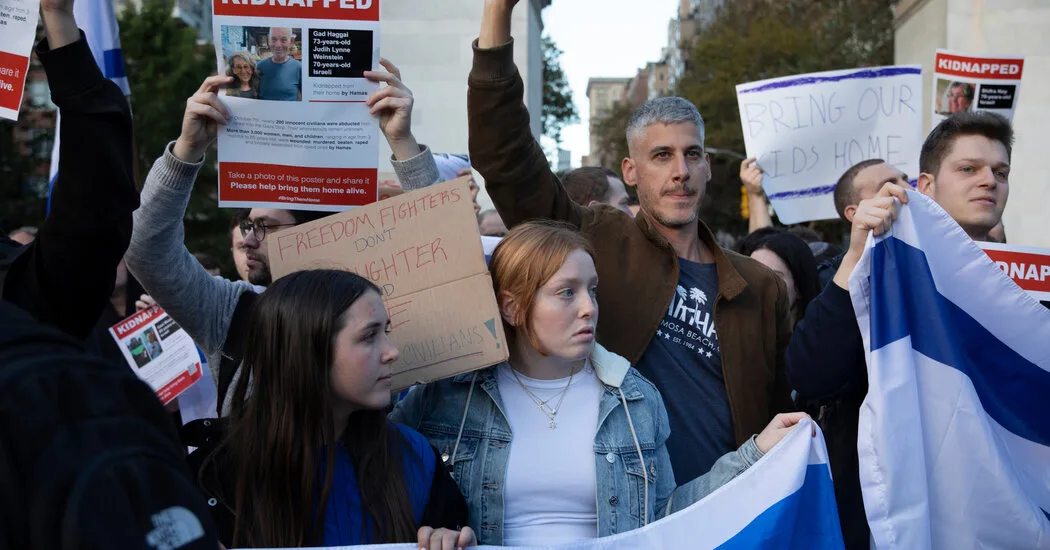
Past student demonstrations sought to challenge the power structure. Now students also want validation.
In what has become a familiar paradigm on college campuses around the country since the start of the war in Israel, hundreds of students at New York University faced one another late Tuesday afternoon in an exchange of chants, accusations and disparagements.
The setting, in this instance, was the north end of Washington Square Park (essentially the university’s campus), where the groups — one standing for Israel, the other for Palestinians — were separated by a line of police officers and the inherently inflexible ideologies amplified by youthful certainty.
Those who had come by way of Students for Justice in Palestine far outnumbered those who stood in support of Israel, though students on both sides expressed a fear of exposure — the doxxing and death threats they worried would come with a too-public expression of solidarity. Some at the rally knew Muslim students who had been on the receiving end of these aggressions.
The hostility particularly upset many of the students on the pro-Palestinian side. One of them, a senior who was Jewish, said he had been raised to be anti-occupation. He could not understand how Jewish students on the left who find themselves now sympathetic to Israel could feel abandoned by the social justice movement. Those students, he said, have the entire global power structure on their side.
Just as the sun had set, one person wearing a kipa entered the park and approached the protests hesitantly before disappearing. He was scared, he told me as he walked off, of engaging with people who obviously hated him. Not long after, an Israeli flag was burned and stomped on by someone who had concealed his face in a kaffiyeh and sunglasses, a look that has been adopted at other student protests.
The risks of too openly taking a side had already been laid bare. Days earlier, a student at New York University’s Law School, Ryna Workman, lost a job offer from the firm Winston & Strawn after sending an email to N.Y.U.’s student bar association placing blame for the initial attack from Hamas on the “state-sanctioned violence” from Israel “that made resistance necessary.” Everyone I spoke to, no matter what their position, asked that I not use their name.
Concerns about reprisal are only the most visible difference in modern protests. The more meaningful shift can be seen in the tenor of campus activism, where historically, a passionate if monolithic view has formed around a grievance, or set of grievances, directed at a consensus enemy. In the late 1960s, it was a unified student body protesting Richard Nixon and the Pentagon; in the ’80s, the apartheid government of South Africa; in the decades ahead, the fossil fuel industry.
In nearly every case, the university itself has stood as co-defendant — an adversary by way of its complicity in whatever injustice, through its morally compromised research or financial investments.
But a different dynamic seemed to be emerging against the backdrop of vastly different expectations. Where the two sides at N.Y.U. converged, beyond the matter of their shared anxiety, was the belief that the university was inadequately supporting them. The day of the protest, an opinion piece in The Washington Square News, the campus newspaper, criticized the university for its “failure to acknowledge its Palestinian students and the pain they are shouldering.”
The writer argued that when “a university ignores its students’ pain, histories and well-being, it fails to serve its communities” and that doing nothing would leave vulnerable students “even more susceptible to potential harm.” Uptown, a similar piece landed in The Columbia Spectator on the same day, titled: “Columbia, You Are Failing Your Palestinian, Muslim, Arab, Black, Brown, and Jewish Student Activists.”
Even though letters sent to the community — from N.Y.U.’s president, Linda Mills, and later, in light of Ryna Workman’s remarks, from the dean of the law school — resolutely condemned Hamas’s attack on Israel, some students felt that the response from the administration has been tepid. At the rally, I approached two students who stood with Israel and handed me a flyer with a picture of an 8-year-old Israeli girl who had been kidnapped by Hamas. One of them, a junior at Stern, N.Y.U.’s business school, identified himself as an Orthodox Jew whose great-grandparents had been imprisoned at Auschwitz and whose parents were in Israel at the beginning of the attacks and found themselves in a bomb shelter.
He showed me a video of students tearing down fliers like the one he had handed me, which had been posted around campus. He was angry that letters to the administrators asking for some sort of action to be taken were not sufficiently acknowledged. He imagined an entirely different and urgent reaction, he said, if the child in the picture had been African American.
The campus protests of the late 1960s sought in part to dismantle the in loco parentis role that colleges and universities had held in American life. But the past two decades have been shaped by a reversal of that, as institutions have sought to reconstruct this role in response to what students and parents paying enormous sums for their education have seemed to want. According to data from the National Center for Education Statistics, during the 2020-21 fiscal year, private four-year colleges spent 40 percent of their budgets on student support services. Over the span of the past 20 years, the dollar amount has more than tripled.
The letter from N.Y.U.’s president, in fact, made reference to some of these services, pointing out that the university’s division of student affairs had reached out “to all students from the affected areas with offers of support and help,” and that students had available to them “24/7” help “through the Wellness Exchange,” a counseling service. But in this especially challenging moment, that seemed not to be enough.
Young people now arrive at elite colleges with the assumption that not only will they be seen, heard and meticulously cared for, but also that their own politics will broadly align with those of the institutions they have chosen to attend. They have been given little reason to think otherwise.
Students, administrators and faculty, at least at places like N.Y.U. and Columbia, shared an antagonism to the Trump presidency and to the police abuses at the heart of the Black Lives Matter movement. Ten years ago, when the former New York City police commissioner, Ray Kelly, was invited to speak at Brown University, students objected. When the administration had him come anyway, protesters interrupted his talk so formidably that the event was shut down.
The current campus protests reflect the limits of the more bonded relationship that students and universities have forged. Presidents beholden to wealthy donors have in many instances been urged by them to stand unequivocally for Israel. This week, John Huntsman Jr., the former governor of Utah and a major donor to the University of Pennsylvania, announced that he and his family would cut their funding because, in his view, the school had not done that. Students, in so many instances, have sought something different. They want their ideas and passions validated. They have rarely experienced the alternative.


